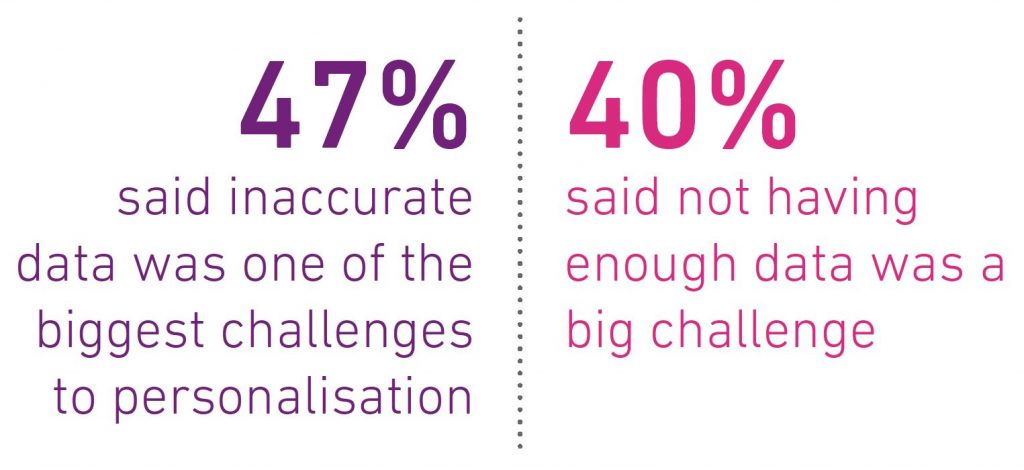We may have been talking about personalisation for many years now but judging by the findings of our recent 2018 Digital Marketer Report it’s a topic that will probably be occupying us for some time yet.
In short, personalisation is something most marketers want and are prioritising but which many people are struggling with. In this post, I’ll dig into how and why brands are prioritising personalisation, what they are currently achieving and the challenges that are currently preventing many of us from taking it further.
Personalisation – what marketers want
The survey behind the report, which we ran December 2017 – January 2018, raised some interesting results regarding personalisation. Two questions stand out. In one we asked what they would ask for if they could have one ‘magic wish’. The most selected option was ‘Be able to tailor your personalisation more accurately and consistently’ (selected by 26% of respondents). Surprisingly,
considerably more chose this answer than those who chose ‘double your marketing budget’.
In total, 51% of respondents said enhancing their knowledge of customers’ needs, attitudes and motivations was a top three priority – the most selected option. From this it’s clear to see that marketers appreciate the need to understand their customers. However, it’s the ability to use this insight that truly drives value – and that’s where personalisation comes in.
The state of personalisation
It seems like most marketers are doing some personalisation. A total of 84% said they were personalising their email campaigns – but this could be as simple as changing a first name.
When we move on to other channels the numbers start to drop; 30% personalise retargeting, 28% personalise on site experience and 20% personalise display advertising. Of course, percentages aren’t everything: personalisation won’t be a major priority for every brand/product and not every brand will use every channel. Despite this, the numbers do lead us to question the sophistication of personalisation being attempted.
But for that we need to look at the types of data and inputs being used to inform personalisation. The most selected option was basic demographic data, for example first name, gender or age (55%). From there the next most selected was geo location data (35%). Loyalty programme data and/or 1st party interaction data, for example email clicks, web browser behaviour or past purchases was used by 28% of respondents.
These are useful but rather limited data sets – more suited to making sure you don’t make a mistake than making the experience more relevant. Only 16% use preference centre data to personalise,
which seems like a huge missed opportunity – this is information people have willingly gone and told you about themselves. Yes, it could mean that these brands don’t have preference centres – to
which I ask – why not?
Finally, only 13% use third party data, meaning all personalisation decisions are made using only data gathered first hand based on your own interactions with that individual. To understand an individual and tailor your interactions/messaging to suit them you need to know more than just what you have based on how they have interacted with you. You need the contextual information that helps build that full picture. Geo-location data goes someway to doing this but what about their likely habits, behaviours and preferences?
Why are we still struggling?
As we have discussed, personalisation has been a ‘hot topic’ for what seems like for ever. But as this report shows, marketers are apparently still struggling and continue to prioritise getting it right. Is there some underlying issue that needs to be rectified?
The answer is probably no. The situation is that personalisation isn’t a simple buzzword that blows over after a year or so. Personalisation is a mainstay of all marketing and will continue to become more and more sophisticated. In many cases, it will be a brand’s ability to personalise and the variety of sources and complexity of what they can manage that will dictate who succeeds and who fails.
The big challenges – so what’s getting in the way?
To round up our coverage of personalisation as a topic in the Digital Marketer Report, we asked respondents what their biggest challenges to more sophisticated personalisation are. As you’d expect much of it revolves around data and data usage.

The most selected option was ‘inaccurate data’ which was selected by 47%. This is understandable because attempting personalisation with inaccurate data is a sure-fire way of achieving the exact opposite of what you want. When the goal is to deliver relevant and tailored experiences, if the information you’re basing the decisioning on is incorrect then the wrong experience will be delivered. This could be something as silly as someone being greeted as their second name (Hello, Bloggs Joe) but could equally mean a potentially embarrassing or irritating piece of content is put in front of exactly the wrong person.
Interestingly, 40% said not having enough data was a factor. Similarly, 42% selected ‘unable to easily access information’ meaning the ability to plug data and information into the system and process to personalise – something that requires the right tech, approach and expertise.
Most surprisingly of all one of the lowest selected barriers was lack of budget (35%). This indicates that there is a definite will at every level of the business to get this right. Rather, what’s lacking is the right volume of accurate data and the expertise and technological ability to use it. It is the brands and marketers who figure out how to overcome these hurdles that will be able to use personalisation as a differentiator.
To find out more about how Experian is leading the market in personalising onsite experiences please click here.
